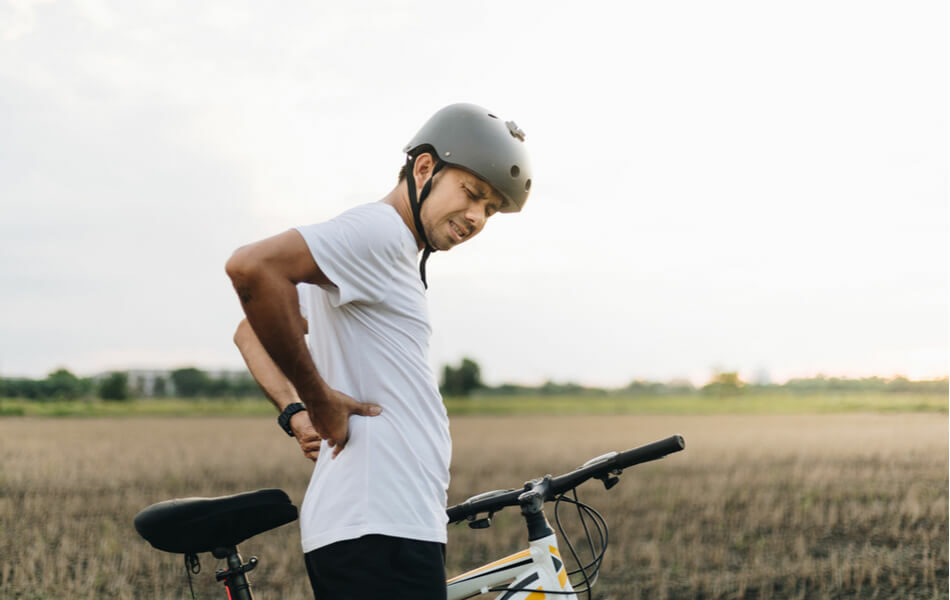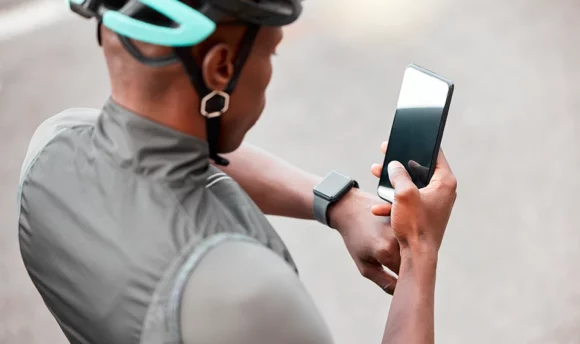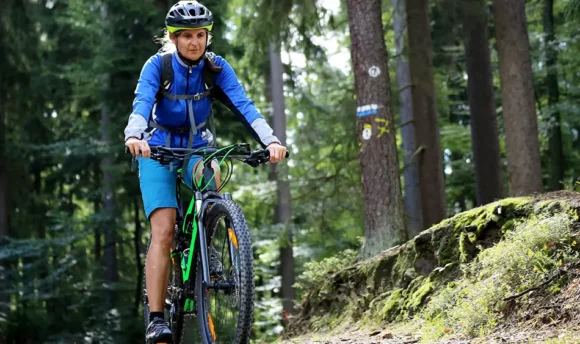How to Prevent Injuries While Cycling? Tips That Will Help You Stay Injury-Free
Find out how to prevent cycling injuries to enjoy your biking experience as much as possible. Learn also how to treat the most common cycling injuries, like road rashes and lower back pain.

Outdoor and indoor cycling is more popular than ever before and is considered one of the best exercises. This is because biking is for people of all ages, plus it has many health benefits.
Cycling can improve cardiovascular health, endurance, and leg and core strength. Even though it’s a great exercise, cycling can lead to injuries, such as road rashes and back pain.
Yet, there are ways to prevent them.
This article presents handy tips that will help you prevent getting injured and get the most out of your cycling experience.
Let’s get into it.
5 Tips to Prevent Getting Injured
Injuries may not be completely unavoidable, yet there are ways to prevent some of them.
Here are 5 tips to prevent getting injured when cycling:
Safety equipment
Wearing protective gear is crucial to staying safe when cycling. In fact, safety equipment is not negotiable and is considered a biking necessity.
Bicycle helmets are, by far, the most common protective equipment. They protect your head while riding and can prevent mild or even fatal head injuries.
Other protective gear includes a safety vest, reflectors, cycling shoes, and perhaps wrist and elbow guards.
A safety vest lets the wearer be seen at all times, especially at night and in other low visibility situations. This way, incoming cars will know the rider’s pre sense and avoid them. Safety vests come in bright colors.
Reflectors have similar use. They’re a common safety device for bicycles and are found on the front, rear, and wheels of the bike. They use retroreflection (i.e., it occurs when a surface returns a light beam back to its original source) to alert other road users of the bicycle’s presence.
So, visit a bike shop to purchase your protective gear!
Choose comfortable clothes
First off, you don’t really need dedicated cycling clothing to enjoy cycling. On the contrary, all you need to do is wear comfortable clothes that allow your body to breathe.
That said, keep in mind that you should avoid poor-quality clothes at all costs since they can cause friction, which results in chafing. On top of this, poor-quality clothes aren’t breathable, meaning you will sweat easily.
Whatever you choose to wear, though, do purchase cycling gloves. These come with a toweling fabric on the back that helps you wipe your sweaty face or nose when it’s cold.
Apart from the gloves, cycling clothing includes but is not limited to shorts, jerseys, tights to combat low temperatures, and trousers.
Stretch before and after the ride
A good warm-up and stretching before and after your ride are paramount in injury prevention. In reality, you should warm up and stretch before and after any exercise, so cycling cannot be an exception to this rule.
Generally, avoid static stretches as they could lead to injuries or short-term strength loss. Instead, perform dynamic stretches.
Choose a bike that fits perfectly
Choosing a bike that fits perfectly can definitely prevent injuries. In fact, as long as you select a bike that fits well, you don’t have to worry about back pain or other injuries.
The reason is simple: cyclists damage their back or other body parts because they select bikes with the wrong height or steering axis.
Supposing you picked the correct bike for your body, this doesn’t mean you’re ready to go cycling. Before you start pedaling, you should adjust your seat height, bike seat position, handlebar height, and handlebar position, among others.
For example, adult bicycle frames are measured from the top of the seat tube to the middle of the bottom bracket. Generally, mountain bike and hybrid bike sizes are given in inches, while road bike sizes are centimeters. In every case, here’s a basic size chart for both road bike and mountain bike sizes:
Road bike size chart
| Height / Inseam | Bike size |
| 5’4″ to 5’8″ with 27″ to 29″ inseam | S (Small) 49cm to 54cm |
| 5’8″ to 5’10” with 29″ to 31″ inseam | M (Medium) 52cm to 56cm |
| 5″10″ to 6′ with 31″ to 33″ inseam | L (Large) 54cm to 58cm |
Mountain bike size chart
| Height / Inseam | Bike size |
| 5’3″ to 5’7″ with 27″ to 29″ inseam | S (Small) 15 inches |
| 5’7″ to 5’11” with 29″ to 31″ inseam | M (Medium) 17 inches |
| 5’11” to 6’2″ with 31″ to 33″ inseam | L (Large) 19 inches |
Regarding the correct height for handlebars and bike seats, it depends on the position of the saddle.
For a performance road position, the top of your steering axis has to be 5–6cm below the middle point of your bike seat. Contrary, for a racing bike position, the top of your steering axis must be a full fist (at least) below the midpoint of your saddle. And when it comes to a recreation bike position, the top of the handlebar needs to be level with the middle point of your bike seat.
Also, do note that you mustn’t keep your knee bent more than 10 degrees and not reach for the pedal as you’re pedaling with your leg. If you do otherwise, you will cause over-extension and a possible injury.
Remember, improper bike fit causes cycling-related injuries and bicycle accidents.
Strength exercises
When it comes to preventing injuries, strength exercises and cross-training are, by far, the most important, especially if you’re preparing for long distances. This is because cross-training helps muscles remain stress-free while cycling.
But, what is cross-training?
Well, it’s a program for exercise that involves different forms of training. When you change the form of your exercise, you can continue to train to improve your overall fitness, strength, and endurance without stressing parts of your body. By changing your exercise, you strengthen different muscles, preventing injuries.
Cross-training can be performed together with cycling (obviously), swimming, running, and elliptical, among others.
What Are the Most Common Cycling Injuries?
Common cycling injuries include lower pain, head injury, neck pain, and road rashes, among others. Even though biking injuries can range from mild to moderate to severe, they can be avoided with proper strength and stretching exercises, as shown above.
The most common cycling injuries:
Lower back pain
One of the most overuse injuries in cycling is lower back pain. To fix it, though, you’d have to first understand why it happens.
As you pedal, the quadriceps pull your pelvis forward.
Now, when you try to keep your body on your bike, your lower back appears to resist the pull.
This action isn’t inherent to the design of the lower back muscles. Hence, the result is that your overworked lower back muscles cause pain.
Don’t fret, though. There’s a way to both prevent and cure your lower back pain. For starters, you’d want to strengthen your glutes and transverse abdominal muscles (i.e., core).
Why?
Because a strong core activates before any movement occurs in the limbs, such as pedaling, and so it removes the stress from the lower back area. And it also works to stabilize the motion.
Alternatively, you could also start running since it has been proven that aerobic exercise helps with back pain.
Head injury
When riding a ride, the chance of falling and wounding your head is a possibility. A helmet, therefore, is a must when cycling as it can protect you from serious injuries.
When it comes to head injuries, there are also other parts you need to be aware of. For instance, neck pain is common to cyclists and is mainly caused by fatigue.
But, the good thing is that neck pain can be alleviated by stretching and strengthening exercises. On top of this, choosing the right bike for you is equally important.
Last but not least, having a tense posture will cause pain in the neck compared to having a relaxed one.
Road rashes
A road rash is another common cycling injury and is inevitable. Sooner or later, everyone experiences it. To put it otherwise, road rash is part of cycling and should be expected.
The way you huddle your road rash wounds and injuries can make the difference and help you recover faster. So, if you treat your wounds correctly, you save lots of suffering and pain. Otherwise, you may damage your whole cycling experience.
What you want to do is first wash your hands, then your injury. After, remove any debris and apply antibiotic ointment. Finally, cover the road rash and use a bandage to keep it tight.
Knee pain
To tell the truth, there are many types of knee pain. These point to different causes with different treatments.
There are four main types of this injury:
- Anterior: This is the front of the knee area. It occurs due to overload, overuse, and muscle fatigue. It appears after repetitive pressures between the femoral groove and the kneecap.
- Posterior: This is the behind the knee area. It’s a common pain complaint and can include tendon injuries, soft-tissue injuries, as well as vascular and neurological causes.
- Medial and lateral pain: This is the sides of the knee area. Medial and lateral pain refers to the pain on the side of your knee closest to the middle of your body. To understand this better, consider that medial translates into the middle.
- IT band syndrome: Also known as iliotibial band syndrome, this type of injury is about a tendon called the iliotibial band. When the tendon gets swollen or irritated from rubbing against your knee bones or hips, it causes pain.
If something’s certain, knee pain can be a sign of riding the wrong bike type or riding it wrong. For example, your saddle position can be improper, causing knee strain. Additionally, this injury is caused by overuse or trying to ride too hard too soon.
To prevent injury, a simple solution is targeted stretching exercises.
A Word From Our Coach
Biking injuries are common among cycling enthusiasts. Some are mild, while others are more severe. In every case, cycling injuries are a reality and almost inevitable.
To protect yourself from such injuries, you’d have to take things seriously. For once, you’d need to choose a bike that fits you perfectly. Then, you’d have to buy protective gear, such as a helmet and cycling clothes. Lastly, starting and ending your biking with warm-up and stretching exercises is a must, too.
Doing all of the above minimizes the chances of injuries, essentially preventing them. For example, you’d prevent injuries like road rashes and lower back pain.
So, don’t take cycling lightly. Take all precautions to ensure a smooth and safe biking experience!
Conclusion
Cycling is wonderful and one of the best exercises available. However, it is possible to injure yourself when biking if you don’t know what you’re doing.
Sure, not all common cycling injuries can be prevented, and that’s fine. But, taking proper precautions can really make the difference between getting injured and enjoying cycling and staying away from injury risk.

















































 Select your language:
Select your language: 








